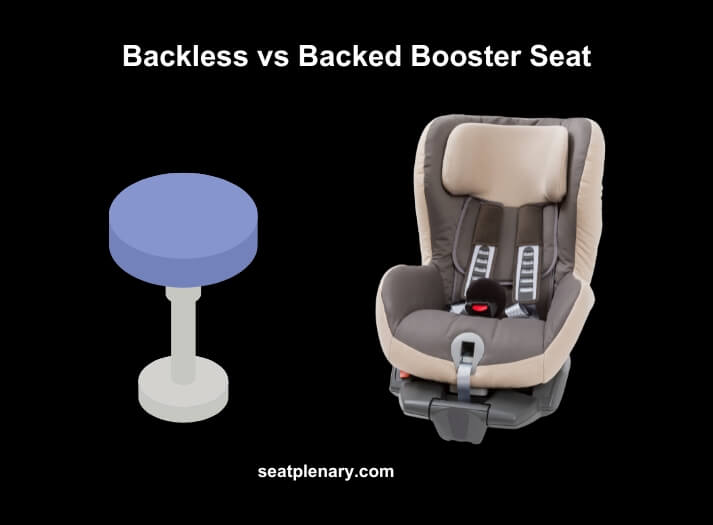As your little one grows like a weed, you may find yourself in a pickle when it comes to choosing the perfect car booster seat. With a myriad of options available, the battle between backless and backed booster seats can seem daunting. Fear not! We’re here to lend a helping hand and guide you through this booster seat showdown. In this article, we’ll explore the differences between backless and backed booster seats, discuss the pros and cons of each, and provide answers to some frequently asked questions to make your decision-making process a breeze.

The Great Booster Debate: Backless vs Backed Booster Seat
What’s the difference?
Before we dive headfirst into the nitty-gritty, let’s quickly define these two contenders. Backless booster seats, as the name suggests, lack a backrest and simply elevate your child to ensure the seat belt fits properly. On the flip side, backed booster seats have a backrest and may include a headrest and side wings for added support and protection.
Backless Booster Seat
Pros:
- Easy to install and transport
- Typically less expensive than backed boosters
- Takes up less space in the vehicle
- Aesthetically less noticeable
Cons:
- No back or head support
- Reduced side-impact protection
- Not suitable for children who tend to fall asleep in the car
- May require additional positioning adjustments for proper seat belt fit
Backed Booster Seat
Pros:
- Provides head, neck, and back support
- Offers better side-impact protection
- Often includes adjustable headrest and shoulder belt guides
- More comfortable for long trips
Cons:
- Bulkier and harder to transport
- Installation may be more complicated
- Typically more expensive than backless boosters
- May not fit well in smaller vehicles
FAQs
When should I switch from a harnessed car seat to a booster seat?
It’s essential to follow the manufacturer’s guidelines for weight and height limits. However, as a rule of thumb, your child should be at least four years old and weigh a minimum of 40 pounds before making the transition to a booster seat.
Which booster seat is safer: backless or backed?
Safety-wise, both backless and backed booster seats are designed to provide proper seat belt positioning. However, backed booster seats offer additional head, neck, and side-impact protection, making them a safer option in most cases.
How do I know if the seat belt fits correctly on a backless booster seat?
A properly fitting seat belt should lie snugly across the upper thighs, not the stomach, and across the middle of the chest and shoulder, not the neck or face. If the seat belt doesn’t fit correctly, consider trying a different booster seat or adjusting the vehicle seat belt.
Can I use a backless booster seat in the front seat of my car?
It’s highly recommended that children under 13 years old ride in the back seat of a vehicle. If it’s absolutely necessary for your child to ride in the front seat, make sure the airbag is turned off or consult your vehicle’s owner manual for guidelines on child seating in the front. Always prioritize your child’s safety first.
How long does my child need to use a booster seat?
Your child should continue using a booster seat until they can properly fit into an adult seat belt. This typically occurs when they reach a height of 4 feet 9 inches (approximately 8-12 years old). It’s essential to follow your local laws and regulations regarding booster seat usage.
Making the Choice: Backless vs Backed Booster Seat
So, how do you choose between a backless and a backed booster seat? Consider the following factors:
- Your child’s age, weight, and height: Make sure your child meets the minimum requirements for using a booster seat and can safely use the booster seat you’re considering.
- Vehicle compatibility: Ensure the booster seat fits well in your car and doesn’t interfere with other passengers’ comfort or safety.
- Frequency of use: If you frequently switch booster seats between vehicles or travel often, a backless booster seat may be more convenient due to its portability.
- Comfort and support: If your child tends to fall asleep in the car or requires additional support, a backed booster seat might be a better choice.
Remember, the most important factor is that the booster seat provides proper seat belt positioning, ensuring your child’s safety on the road.
Last Remarks
When it comes to the backless vs backed booster seat debate, there’s no one-size-fits-all answer. The best booster seat for your child ultimately depends on their specific needs, your vehicle, and your lifestyle. Take the time to research and compare different booster seats, keeping in mind the pros and cons of each type. When in doubt, consult with a certified Child Passenger Safety Technician for personalized advice. Stay safe and happy travels!
You May Like These Resources:
